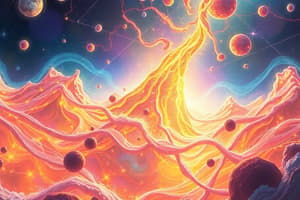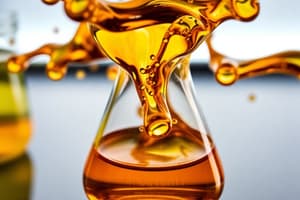Podcast
Questions and Answers
Which of the following processes leads to an increase in entropy?
Which of the following processes leads to an increase in entropy?
- Melting of a solid (correct)
- Freezing of a liquid
- Deposition of a gas directly to a solid
- Condensation of a gas
According to the second law of thermodynamics, what happens to the entropy of the universe in a spontaneous process?
According to the second law of thermodynamics, what happens to the entropy of the universe in a spontaneous process?
- It fluctuates unpredictably
- It remains constant
- It decreases
- It increases (correct)
Which of the following conditions will always result in a spontaneous process?
Which of the following conditions will always result in a spontaneous process?
- Endothermic with increasing disorder at low temperatures
- Exothermic with decreasing disorder
- Exothermic with increasing disorder (correct)
- Endothermic with decreasing disorder
What does a $ΔG$ value of zero indicate for a reaction at constant temperature and pressure?
What does a $ΔG$ value of zero indicate for a reaction at constant temperature and pressure?
For a certain reaction, $ΔH = -100 kJ$ and $ΔS = -50 J/K$. At what temperature does the reaction become spontaneous?
For a certain reaction, $ΔH = -100 kJ$ and $ΔS = -50 J/K$. At what temperature does the reaction become spontaneous?
How does the Gibbs free energy change ($ΔG$) relate to the maximum amount of work available from a process?
How does the Gibbs free energy change ($ΔG$) relate to the maximum amount of work available from a process?
When calculating the standard Gibbs free energy change ($ΔG°$) for a reaction using standard free energies of formation, what must be considered?
When calculating the standard Gibbs free energy change ($ΔG°$) for a reaction using standard free energies of formation, what must be considered?
What is the correct expression for calculating the standard Gibbs free energy change ($ΔG°$) for a reaction?
What is the correct expression for calculating the standard Gibbs free energy change ($ΔG°$) for a reaction?
What variables are related by the equation $ΔG = -RTlnK$?
What variables are related by the equation $ΔG = -RTlnK$?
How does increasing the temperature typically affect the rate of a chemical reaction?
How does increasing the temperature typically affect the rate of a chemical reaction?
Which of the following is true regarding the Gibbs Free Energy?
Which of the following is true regarding the Gibbs Free Energy?
What condition is necessary for a reaction to be at equilibrium?
What condition is necessary for a reaction to be at equilibrium?
Which of the following parameters does NOT affect the rate of a reaction?
Which of the following parameters does NOT affect the rate of a reaction?
In an endothermic reaction at equilibrium, what effect would increasing the temperature have on the equilibrium constant (K)?
In an endothermic reaction at equilibrium, what effect would increasing the temperature have on the equilibrium constant (K)?
For the reaction $N_2(g) + 3H_2(g)
ightleftharpoons 2NH_3(g)$, how will a decrease in volume (increase in pressure) affect the equilibrium?
For the reaction $N_2(g) + 3H_2(g) ightleftharpoons 2NH_3(g)$, how will a decrease in volume (increase in pressure) affect the equilibrium?
Given that heat flows from warmer to colder objects, which of the following scenarios demonstrates an increase in entropy?
Given that heat flows from warmer to colder objects, which of the following scenarios demonstrates an increase in entropy?
Consider a reaction where enthalpy is positive and entropy is negative, so that $ΔH > 0$ and $ΔS < 0$. What can you conclude about the spontaneity of this reaction?
Consider a reaction where enthalpy is positive and entropy is negative, so that $ΔH > 0$ and $ΔS < 0$. What can you conclude about the spontaneity of this reaction?
What is the significance of Gibbs free energy (G) in predicting the spontaneity of a reaction?
What is the significance of Gibbs free energy (G) in predicting the spontaneity of a reaction?
Which of the following best describes a reversible change in a system?
Which of the following best describes a reversible change in a system?
Which of the following best describes an irreversible change?
Which of the following best describes an irreversible change?
Consider the reaction: $A(g) + B(g) \rightleftharpoons C(g)$. At equilibrium, the partial pressures are $P_A = 1 atm$, $P_B = 2 atm$, and $P_C = 4 atm$. Calculate the equilibrium constant $K_p$.
Consider the reaction: $A(g) + B(g) \rightleftharpoons C(g)$. At equilibrium, the partial pressures are $P_A = 1 atm$, $P_B = 2 atm$, and $P_C = 4 atm$. Calculate the equilibrium constant $K_p$.
A reaction has an equilibrium constant $K = 0.05$ at 298 K. What does this indicate about the reaction?
A reaction has an equilibrium constant $K = 0.05$ at 298 K. What does this indicate about the reaction?
For a reaction where $ΔH < 0$ and $ΔS > 0$, how does temperature affect the spontaneity of the reaction?
For a reaction where $ΔH < 0$ and $ΔS > 0$, how does temperature affect the spontaneity of the reaction?
What is the effect of a catalyst on Gibbs Free Energy ($ΔG$)?
What is the effect of a catalyst on Gibbs Free Energy ($ΔG$)?
Which of the following has the highest amount of entropy?
Which of the following has the highest amount of entropy?
Based on the equation $ΔG = ΔH - TΔS$, what happens to the spontaneity of an endothermic reaction ($ΔH > 0$) with increasing temperature?
Based on the equation $ΔG = ΔH - TΔS$, what happens to the spontaneity of an endothermic reaction ($ΔH > 0$) with increasing temperature?
If the equilibrium constant (K) for a reaction is very large, what does this imply about the free energy change ($ΔG$)?
If the equilibrium constant (K) for a reaction is very large, what does this imply about the free energy change ($ΔG$)?
Which of the following reactions would be most favored at high temperatures, assuming enthalpy is positive?
Which of the following reactions would be most favored at high temperatures, assuming enthalpy is positive?
For a certain reaction, $ΔH = +50 kJ/mol$ and $ΔS = +100 J/mol • K$. At what temperature will the reaction be at equilibrium? (Assume $ΔH$ and $ΔS$ are independent of temperature.)
For a certain reaction, $ΔH = +50 kJ/mol$ and $ΔS = +100 J/mol • K$. At what temperature will the reaction be at equilibrium? (Assume $ΔH$ and $ΔS$ are independent of temperature.)
If a reaction is spontaneous at low temperatures but becomes non-spontaneous at high temperatures, what must be true about its enthalpy and entropy changes?
If a reaction is spontaneous at low temperatures but becomes non-spontaneous at high temperatures, what must be true about its enthalpy and entropy changes?
A system is closed. If its entropy decreases, what must be true of its surroundings?
A system is closed. If its entropy decreases, what must be true of its surroundings?
For an ideal gas expanding into a vacuum (Joule expansion), what are the values of $ΔH$ and $ΔS$?
For an ideal gas expanding into a vacuum (Joule expansion), what are the values of $ΔH$ and $ΔS$?
How does an increase in pressure affect the entropy of a gas?
How does an increase in pressure affect the entropy of a gas?
For the Haber process ($N_2(g) + 3H_2(g) \rightleftharpoons 2NH_3(g)$) which is exothermic, what conditions favor the formation of ammonia ($NH_3$)?
For the Haber process ($N_2(g) + 3H_2(g) \rightleftharpoons 2NH_3(g)$) which is exothermic, what conditions favor the formation of ammonia ($NH_3$)?
What is the standard state condition used for calculating standard Gibbs free energy change?
What is the standard state condition used for calculating standard Gibbs free energy change?
For a reaction with a positive enthalpy change and a positive entropy change, at what temperature will the process switch from non-spontaneous to spontaneous?
For a reaction with a positive enthalpy change and a positive entropy change, at what temperature will the process switch from non-spontaneous to spontaneous?
The reaction $A \rightarrow B$ has an activation energy of $E_a$. Which of the following can increase the rate of reaction without altering the temperature?
The reaction $A \rightarrow B$ has an activation energy of $E_a$. Which of the following can increase the rate of reaction without altering the temperature?
If the potential energy of the products in a reaction is higher than the potential energy of the reactants, what can be said about the sign of $ΔH$ and the type of reaction?
If the potential energy of the products in a reaction is higher than the potential energy of the reactants, what can be said about the sign of $ΔH$ and the type of reaction?
Flashcards
Entropy
Entropy
A measurable quantity representing the disorder in a system or surroundings.
Boiling Point
Boiling Point
The temperature at which a liquid's vapor pressure equals the surrounding atmospheric pressure.
Conduction
Conduction
Heat transfer through direct contact between objects or substances.
Convection
Convection
Signup and view all the flashcards
Change in Entropy (ΔS)
Change in Entropy (ΔS)
Signup and view all the flashcards
Heat
Heat
Signup and view all the flashcards
Heat
Heat
Signup and view all the flashcards
2nd Law of Thermodynamics
2nd Law of Thermodynamics
Signup and view all the flashcards
Gibbs' Free Energy (G)
Gibbs' Free Energy (G)
Signup and view all the flashcards
Exothermic
Exothermic
Signup and view all the flashcards
Endothermic
Endothermic
Signup and view all the flashcards
Spontaneous Process
Spontaneous Process
Signup and view all the flashcards
Standard Free Energy of Formation (ΔG°f)
Standard Free Energy of Formation (ΔG°f)
Signup and view all the flashcards
Spontaneous Reaction (ΔG < 0)
Spontaneous Reaction (ΔG < 0)
Signup and view all the flashcards
Nonspontaneous Reaction (ΔG > 0)
Nonspontaneous Reaction (ΔG > 0)
Signup and view all the flashcards
Factors Affecting Reaction Rate
Factors Affecting Reaction Rate
Signup and view all the flashcards
Gibbs Free Energy Change (ΔG)
Gibbs Free Energy Change (ΔG)
Signup and view all the flashcards
R
R
Signup and view all the flashcards
ln K
ln K
Signup and view all the flashcards
Equilibrium
Equilibrium
Signup and view all the flashcards
Equilibrium Constant (K)
Equilibrium Constant (K)
Signup and view all the flashcards
Law of Mass Action
Law of Mass Action
Signup and view all the flashcards
Study Notes
Entropy and Gibbs' Free Energy: General Chemistry II
- Entropy and Gibbs’ Free Energy are discussed in Chemistry II.
Lesson Outline
- Second Law of Thermodynamics
- Entropy
- Gibbs’ Free Energy
Recall
- Boiling Point: The temperature at which the vapor pressure of a liquid equals the atmospheric pressure.
- Conduction: Heat transfer between two touching objects.
- Convection: Heat transfer between an objects and the liquid or air that surrounds them.
- Entropy: A measurable quantity, noted as ΔS, that represents the disorder in a system or its surroundings.
- Heat: A means by which energy is transferred from a hot to a colder body in thermal contact.
Lesson Objectives
- Spontaneity of a process can be predicted based on entropy.
- The second law of thermodynamics and its significance can be explained.
- Gibbs' free energy can be used to determine the direction of a reaction.
Heat
- Is a form of energy.
- Flows from warmer to colder objects.
- Heat sources include the Sun, fire, and appliances.
Entropy
- Entropy is a measurable quantity, often noted as ΔS that represents the disorder in the system or surroundings.
- Entropy change in states:
- Solid to liquid: Increase in entropy.
- Liquid to gas: Increase in entropy.
- Gas to liquid: Decrease in entropy.
- Fusion: Increase in entropy.
- Freezing: Decrease in entropy.
- Combustion: Increase in entropy.
- Entropy increases as the state changes from solid to liquid to gas.
- Solid state has the least entropy.
- Liquid state has medium entropy
- Gaseous state has the most entropy
Second Law of Thermodynamics
- For an isolated entity, the entire universe's state of entropy will always increase over time.
Gibbs' Free Energy (G)
- Gibbs' Free Energy (G) incorporates enthalpy and entropy into a single value.
- The change in free energy, G, equals the enthalpy sum plus the system's temperature and entropy product.
Gibbs Free Energy and Spontaneity:
| ΔG | Spontaneity |
|---|---|
| Negative | Spontaneous |
| Positive | Non-spontaneous |
- ΔG < 0: Exothermic and Increasing Disorder; Spontaneous.
- ΔG < 0: Exothermic and Decreasing Disorder; Spontaneous at low temperatures.
- ΔG < 0: Endothermic and Increasing Disorder; Spontaneous at high temperatures.
- ΔG > 0: Endothermic and Decreasing Disorder; Non-Spontaneous.
Key Figures
- Josiah Willard Gibbs produced Gibbs' energy in the 1870s.
- He called this energy the "available energy" in a device.
- Gibbs' paper, "Graphical Methods in the Thermodynamics of Fluids," was published in 1873.
- Gibbs' equation predicts the behavior of systems when combined.
- The quantity is the chemical reaction-related energy that can be used to do the work and is the sum of its enthalpy (H) and the system's temperature and entropy (S) product.
- G = H - TS or more completely as G = U + PV - TS, where:
- U is internal energy (SI unit: Joule)
- P is pressure (SI unit: Pascal)
- V is volume (SI unit: m³)
- T is temperature (SI unit: Kelvin)
- S is entropy (SI unit: Joule/Kelvin)
- H is the enthalpy (SI unit: Joule)
Gibbs Free Energy Equation
- The relationship of ΔG, ΔS, and ΔH is summarized by the equation: ΔG = ΔH - TΔS
- ΔG is the change in free energy.
- ΔH is the change in enthalpy.
- TΔS is the temperature times the change in entropy.
- The factors affect ΔG of a reaction (assume ΔH and ΔS are independent of temperature).
- ΔG = ΔH - TΔS
- For an isothermal process it can be expressed as: ΔG= ΔH - TΔS or at standard condition ΔG°= ΔH° - TΔS°
Gibbs Free Energy Examples:
- ΔG for a reaction can be calculated where ΔH° is equal to 36.2 kJ and ΔS° is equal to 123 J/K at 298 K to determine if the reaction is spontaneous.
- The standard Gibbs free energy change, ΔG°, for a reaction can be calculated from the standard free energies of formation, ΔG°f : ΔG° = ΣnΔG°f (products) - ΣmΔG°f (reactants)
- Where n and m are the coefficients in the balanced chemical equation of the reaction.
Gibbs Free Energy
- ΔG°r = ΣnG°f (products) - ΣnG°f (reactants)
- ΔG° > 0, backwards reaction with deficient energy
- ΔG° < 0, forwards reaction with excess energy
- ΔG° = 0, reaction is in equilibrium
- ΔG° is a measure of the driving force
- ΔG°f = free energy of formation
Gibbs Free Energy Equation and Usage
- ΔG = -RTlnK explains where and how to use it.
- Gibbs free energy change, R=Ideal gas constant, T=Temperature
Factors Affecting Reaction Rate:
- Temperature
- Concentration
- Catalyst
Gibbs’ Free Energy: ΔG = -RTlnK
- Delta G = Gibbs free energy change for a chemical reaction (Units: J/mol or kJ/mol)
- R = Ideal gas constant (R= 8.314 J/K.mol)
- T = Absolute temperature (Unit: K)
- ln K = Natural logarithm of the equilibrium constant (K) for the reaction (Unitless)
Breakdown of Gibbs Free Energy
- Gibbs free energy change (ΔG) refers to reversible work done on a system at constant temperature and pressure.
- ΔG quantifies the energy converted to useful work during a process.
- For a reversible reaction, A + B ⇌ C + D:
- If ΔG < 0: The reaction is thermodynamically favored and spontaneous in the forward direction.
- If ΔG > 0: The reaction is non-spontaneous in the forward direction, requiring some external interference to propel it forward.
- If ΔG = 0: The reaction is at equilibrium, where the rate of forward reaction equals the rate of backward reaction.
Chemical Equilibrium:
- For a reversible reaction: aA + bB ⇌ cC + dD
- K = ([C]^c [D]^d) / ([A]^a [B]^b)
Equilibrium
- Equilibrium is a state where there are no observable changes as time goes by.
- Chemical equilibrium is achieved when:
- The rates of the forward and reverse reactions are equal.
- The concentrations of reactants and products remain constant.
- There are two types of equilibrium: Physical and Chemical.
- Physical Equilibrium: H₂O (l) ⇌ H₂O (g)
- Chemical Equilibrium: N₂O₄ (g) ⇌ 2NO₂
Law of Mass Action
- For a reversible reaction at equilibrium and constant temperature, a certain ratio of reactant and product concentrations has a constant value (K).
- The Equilibrium Constant (K) is a number equal to the ratio of the products' equilibrium concentrations to the reactants' equilibrium concentrations, each raised to the power of its stoichiometric coefficient.
- For the general reaction: aA (g) + bB (g) ⇌ cC (g) + dD (g)
- K = [C]^c [D]^d / [A]^a [B]^b
Changes Caused By Heat:
- Reversible changes can be undone, allowing the object to return to its original form.
- Irreversible changes cannot be undone and cause the object to completely change or become another substance.
Studying That Suits You
Use AI to generate personalized quizzes and flashcards to suit your learning preferences.





